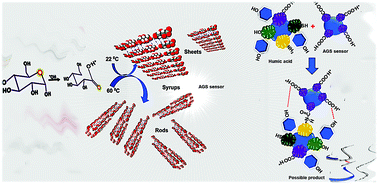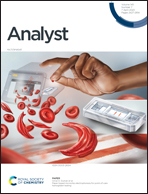Detection of humic acid in water using flat-sheet and folded-rod viscous alkaline glucose syrups†
Abstract
The utility of a low-cost biocompatible material for the detection of pollutants in water is highly essential to ensure safety and economic efficiency. In this paper, solutions of two viscous alkaline glucose syrups (AGS@22-sheet and AGS@60-rod), obtained under two different temperature conditions (22 °C and 60 °C) were used to detect low levels of humic acid (HA), a carcinogen pro-molecule and metal-complexing agent in an aqueous solution. The AGS materials were characterized using ultraviolet-visible spectroscopy (UV-Vis), Fourier transform infrared spectroscopy and scanning electron microscopy (SEM). By evaluation, a detection limit (LOD) as low as 4.6 × 10−5 mg L−1 was obtained. The sensing capability of the new technology was further extended to the detection of HA in a real water sample (tap water) using the standard addition method with 98 and 100.05% recoveries. The sensing was improved in the presence of sodium acetate and sodium citrate and was found to follow a pseudo-first order reaction. These findings show that the as-synthesized glucose syrups have the potential to detect humic acid in water and thus may be employed for the quantification of HA in water treatment plants or textile industry.



 Please wait while we load your content...
Please wait while we load your content...